#hiyoshi taisha
Explore tagged Tumblr posts
Text
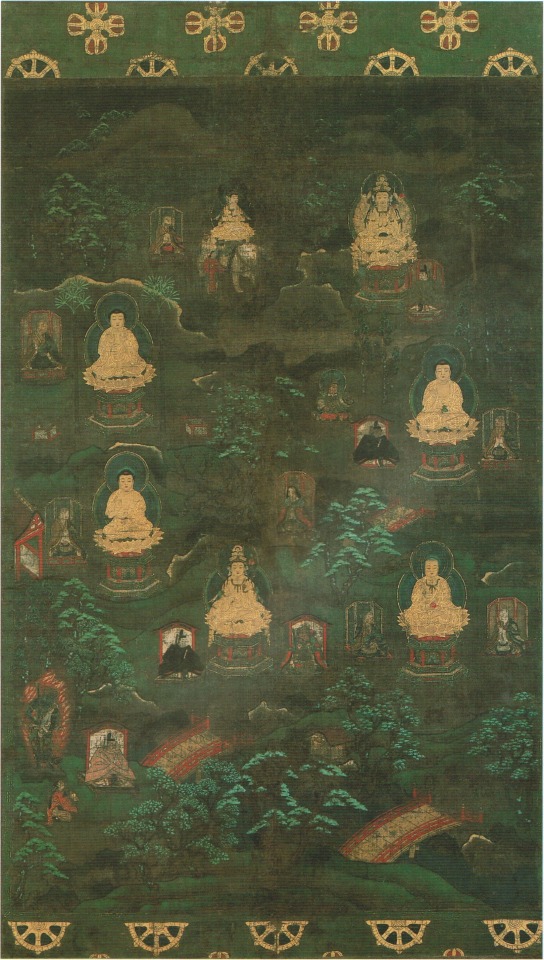
A hanging scroll of the Hie Sanno Mandara (日吉山王曼荼羅), a mandala depicting the local deities of Hie Jinja Shrine (日吉神社), i.e. present-day Hiyoshi Taisha Grand Shrine (日吉大社) in Ōtsu, Shiga Prefecture, as manifestations of the Buddhist divinities of Mount Hiei (比叡山) north of Kyoto, with the deities and divinities matched up throughout the landscape of the mountain
Color on silk dating to the Kamakura period (1185-1333) from the collection of Hyakusaiji Temple (百済寺) in Higashiōmi, Shiga Prefecture
Image from "Shintō: The Sacred Art of Ancient Japan" edited by Victor Harris, published by the British Museum Press. 2001, page 173
#japanese art#buddhist art#曼荼羅#mandala#滋賀県#shiga prefecture#東近江市#higashiomi#百済寺#hyakusaiji#天台宗#tendai#比叡山#hieizan#mount hiei#日吉神社#hie jinja#日吉大社#hiyoshi taisha#日吉山王曼荼羅#hie sanno mandara#crazyfoxarchives#arte budista#arte japonés
29 notes
·
View notes
Text
Japanese Monkey God
User @red-lights-burning asked if there was a connection between Sun Wukong and the monkey gods of Japan. They provided lovely info, which was split between two asks, but I decided to put everything together into a single post.
@red-lights-burning asked: Japan has their own monkey protector named Masaru AKA Sannō Gongen, who was created back in the early 9th century by Tendai Buddhist sect founder Saichō shortly after he returned from China. So it makes me think if Monkey King was already a thing in the 800’s and if he was one of the inspirations for Masaru. A description from onmarkproductions (a really great site for anyone curious about Japanese Buddhism and Shintō) MASARU 神猿 Literally “Kami Monkey.” Masaru is the sacred monkey and protector of the Hie Shrine (aka Hie Jinja 日吉神社, Hiyoshi Taisha 日吉大社). The term “Masura” is often translated as “excel,” reflecting the belief that this sacred monkey can overcome all obstacles and prevail against all evil. Masaru is thus considered a demon queller par excellence (魔が去る・何よりも勝る). In the Heian era, Masaru (also translated “Great Monkey”) was invoked in Kōshin rituals to stop the three worms from escaping the body. Masaru also appears in Japanese scrolls used in Koushin rites. Here’s a couple other descriptions SANNŌ GONGEN 山王 権現 SARUGAMI 猿神 Fertility, Childbirth & Marriage Monkeys are patrons of harmonious marriage and safe childbirth at some of the 3,800 Hie Jinja shrines in Japan. These shrines are often dedicated to Sannō Gongen 山王権現 (lit. = mountain king avatar), who is a monkey. Sannō is the central deity of Japan’s Tendai Shinto-Buddhist multiplex on Mt. Hiei (Shiga Prefecture, near Kyoto). The monkey is Sannou’s Shinto messenger (tsukai 使い) and Buddhist avatar (gongen 権現). The monkey messenger is also known as Sarugami (猿神; literally “monkey kami”). Sarugami is the Shinto deity to whom the three monkeys (hear, speak, see no evil) are reportedly faithful. The monkey shrine at Nakayama Shrine 中山神社 in Tsuyama City, Okayama Prefecture, is dedicated to a red monkey named Sarugami, who blesses couples with children. According to shrine legends, the local people at one time offered human sacrifices (using females) to this deity. The shrine is mentioned in the Konjaku Monogatari-shu (今昔物語集), a collection of over 1000 tales from India, China, and Japan written during the late Heian Period (794-1192 AD). Sarugami, like Sannou Gongen, is also worshipped as the deity of easy delivery and child rearing. At such shrines, statues of the monkey deity are often decked in red bibs -- a color closely associated with fertility, children, and protection against evil forces and diseases like smallpox.
My answer:
I've read only a little bit about Japanese monkey gods. I previously referenced Sarugami in my article about the possible shamanic origins of primate-based boxing in China. Part of footnote #14 reads:
In Japan, monkeys were also associated with horses and healing via the warding of evil. Apart from monkeys being kept in stables like their Chinese counterparts, their fur was applied to the harnesses and quivers of Samurai because the warriors believed it gave them more control over their mounts. Furthermore, monkey body parts have been consumed for centuries as curative medicines, and their hides have even been stuffed to make protective amulets (kukurizaru) to ward off illness. Likewise, a genre of painting depicts divine monkeys (saru gami), messengers of the mountain deity, performing Da Nuo-like dances to ensure a good rice harvest (Ohnuki-Tierney, 1987, pp. 43-50)
The aforementioned article suggests a connection between monkeys and the Shang-Zhou Da Nuo (大儺 / 難; Jp: Tsuina, 追儺) ritual, an ancient, war-like, shamanic animal dance designed to drive away demonic illness and influences. The pertinent section reads:
It’s possible that the “twelve animals” of the Da Nuo exorcism refer to some precursor of the Chinese zodiacal animals (rat, ox, tiger, rabbit, dragon, snake, horse, goat, monkey, rooster, dog, and pig). If true, monkey fur could have been among the animal products worn by the ritual army. After all, monkeys have long been associated with curing illness and expelling evil in East Asia. [14] A modern example of exorcists who don monkey fur are the shamans of the Qiang ethnic group of Sichuan. The Qiang worship monkeys as the source and savior of their sacred knowledge, as well as the progenitor of their people, the latter being a myth cycle common among ethnic groups of Tibet and southwestern China.
This is the only relevant info that comes to mind. But based on what I know, I would guess that Sun Wukong and the monkey gods of Japan draw upon the same cultural sources. I hope this helps.
Source:
Ohnuki-Tierney, E. (1987). The Monkey as Mirror: Symbolic Transformations in Japanese History and Ritual. Princeton: Princeton University Press.
#asks#Sun Wukong#Monkey King#Journey to the West#JTTW#Japanese Buddhism#Shinto#Buddhism#monkey god#shamanism#Lego Monkie Kid#LMK
77 notes
·
View notes
Text

Autumn, Hiyoshi Taisha, Otsu, Shiga, Japan, 日吉大社, 大津, 滋賀, 紅葉
3 notes
·
View notes
Text
Torii
The Origins of Torii
There are two kinds of Sandō (road that approaches the shrine), a road that comes from a town or city and continues to the shrine, and the road from the entrance of the shrine to the Haiden (Prayer Hall) • Honden (Main Hall). Both are sacred roads in which visitors walk, and mikoshi are carried along the path. Therefore in order to demarcate the sacred land, torii, koma inu, stone lanterns, etc… are placed. Koma inu, and stone lions will be discussed later on, here is where torii are being discussed. In fact the origin of Torii is not clear. From extant examples and paintings in picture scrolls, it is known that a similar type of torii existed in the 12th century, but it is not known when and for what purpose they were built.
Why are there so many different types of Torii?
The present torii gate functions as a symbolic gateway, indicating that the area inside (beyond) the gateway is sacred ground. It also serves as a warning that any disrespectful behavior beyond the gate will result in punishment. Another feature of torii gates is that there are many types. It is said that the shape of the torii may have indicated the type of kami, but this is not certain. The form can be broadly classified into the Shinmei type and the Myojin type. While the Shinmei type is simple, the Myojin type is highly decorative and sometimes painted in vermilion. This may be related to the fact that Myojin-style torii are often erected at shrines of common people’s beliefs, as they have a strong sense of Shinto/Buddhist syncretism.

Parts of a Torii Gate
笠木 Kasagi
Cap Piece that covers the top of a Torii
島木 Shimagi
Long horizontal timber above the columns on a Torii, right below the Kasagi
台輪 Daiwa
The single piece placed where the columns meet the Shimagi, believed to prevent rot from setting in from the top of the pillars
額束 Gakutsuka
The plaque that holds the name of the shrine
楔 Kusabi
Wedges/Lynchpins
貫 Nuki
Lower horizontal timber, traditionally does not pierce the columns, and in Shinmei style torii, is said to be round
柱 Hashira
The two vertical columns leading up to the horizontal bars
藁座 Waraza
Reinforcement for the Daīshi at the bottom of the torii
台石 Daīshi
Stone pedestal at the bottom of torii
亀腹 Kamebara
White plaster bun-shaped mounds used to reinforce support base stones.
Varieties of Torii
神明系 Shinmei Style

Image Sources: 1 , 2 , 3 , 4
黒木鳥居 Kurogi Torii
Made from logs where the outer bark is still attached. Seen at shrines like 野宮神社 Nonomiya Jinja.
鹿島鳥居 Kashima Torii
The lower cross bar is quadrilateral (instead of rounded), and sticks out past the pillars holding the torii up. Seen at shrines like 鹿島神宮 Kashima Jingū.
神明鳥居 Shinmei Torii
The pillars, top crossbar and lower crossbar are all rounded. See at shrines like 神明宮 Shinmeigū.
伊勢鳥居 Ise Torii
The upper crossbar is pentagonal in shape. Seen at shrines like 伊勢神宮内宮・外宮 Ise Jingū Naikū • Gekū and 熱田神宮 Atsuta Jingū
明神系 Myojin Style
Usually these have the cap piece called a Kasagi while Shinmei do not

八幡鳥居 Hachiman Torii
The edge of the top bar is slanted. Seen at shrines like 岩清水八幡宮 Iwashimizu Hachimangū.

台輪(稲荷)鳥居 Daiwa (Inari) Torii
Below the upper crossbar are Daiwa (see above definition). Seen at shrines like 伏見稲荷大社 Fushimi Inari Taisha.

春日鳥居 Kasuga Torii
Less warping of the cap piece and upper crossbar (fairly flat). Seen at shrines like 春日大社 Kasuga Taisha.

両部鳥居 Ryōbu Torii
Has smaller support columns attached to the main pillars. Seen at shrines like 厳島神社 Itsukushima Jinja, and 氣比神宮 Kehi Jingū.
中山鳥居 Nakayama Torii
The same as a Myōjin Torii, except the lower crossbar doesn’t stick out. Seen at shrines like 中山神社 Nakayama Jinja.

Image Sources: 1 , 2
明神鳥居 Myōjin Torii
Both the upper and lower crossbars have warping (meaning they’re more curved). Seen at shrines like 神田明神 Kanda Myōjin.

山王鳥居 Sannō Torii
Above the Kasagi, there is an extra part called the Gasshō, which is a triangular shaped piece. Seen at shrines like 日吉大社 Hiyoshi Taisha.

三輪鳥居 Miwa Torii
To the sides are smaller support torii. Seen at shrines like 大神神社 Ōmiwa Jinja.
Translations of this page

4 notes
·
View notes
Text
Shinshi (Divine Servant)
The link did not include the chart, but I found one on the Japanese Wikipedia and machine translated it. The translation is below.
animal God mouse Daikokuten cow Tenmangu Shrine * See Tenjin Faith tiger Chogosonshiji Temple bee Futarasan Shrine rabbit Sumiyoshi Taisha Shrine / Okazaki Shrine / Toshi Shrine turtle Matsuo Taisha Shrine crab Kotohira Shrine eel Mishima Taisha Shrine snake Benzaiten・ sea serpent Izumo Taisha Shrine white snake Suwa Shrine Omiwa Shrine fox Inari Shrine * See Inari God . deer Kasuga Taisha Shrine / Kashima Shrine monkey Hiyoshi Taisha Shrine / Asama Shrine crow Kumano Sanzan , Itsukushima Shrine crane Suwa Taisha Shrine pigeon Hachiman Shrine heron Kehi Shrine chicken Ise Shrine , Atsuta Shrine , Isonokami Shrine wolf Shrines in the Okutama / Chichibu region such as Musashi Mitake Shrine and Mitsumine Shrine carp Omae Shrine boar Go'o Shrine / Wake Shrine centipede Bishamonten
Here is a link to the original text.
#Japanese Mythology#Animal#Shinshi#Divine Servant#Shinto#Mouse Spirit#Cow Spirit#Tiger Spirit#Bee Spirit#Rabbit Spirit#Turtle Spirit#Crab Spirit#Eel Spirit#Snake Spirit#Sea Serpant Spirit#Fox Spirit#Deer Spirit#Monkey Spirit#Crow Spirit#Crane Spirit#Pigeon Spirit#Heron Spirit#Chicken Spirit#Wolf Spirit#Carp Spirit#Boar Spirit#Centipede Spirit#Animal Spirit
4 notes
·
View notes
Note
👍Why not Shou and Nazrin!
A Shared Headcanon To show appreciation for all of Nazrin's hard work, (and possibly to keep her from eating all the stone statues and scrolls around the temple when upset) Shou had a second "Nezumi no Hokura" like the one at Hiyoshi Taisha built just down the road from Myouren. She told Nazrin it faced Enryaku-ji defiantly like the original, but inside the border of Gensokyo it is hard to tell. It is the thought that counts and it has kept Nazrin appeased for now.
#ask meme#momigeddon#muse: nazrin#I need to finish her profile but my Nazrin is based on Tesso the Iron Rat
0 notes
Text
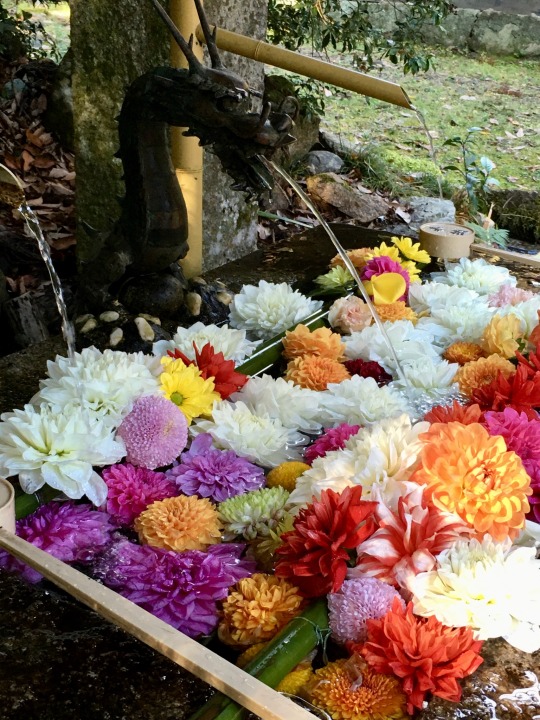
Hiyoshi Taisha, Otsu city 🌸🍁
#japan#japan photography#japan photos#owlet’s photos#i went from here up to mt hiei to see the leaves today and it was incredible#but altitude sickness struck which i need to mitigate because i want to go back#when it snows#shiga#otsu#kyoto#hiyoshi taisha
100 notes
·
View notes
Photo

Various pictures of the many autumn spots of Hiyoshi Taisha (日吉大社) in Ōtsu City, Shiga Prefecture, Japan.
53 notes
·
View notes
Text
The list of real-life places related to series I love that I have managed to visit this year keeps on growing.
Yesterday, I went to Shiga, the prefecture where Donten ni Warau is set in. I visited Oumihachiman with a friend, which in my opinion is the best place to have a taste of how life was back then.
We left the town planning to come back and visit the ninja village in Kouka, which isn’t too far from it. We might also visit Hikone and Samegai-juku while we’re at it.
A decade after getting into the Warau series, I finally understand why Karakara-sensei decided to create this story. It was begging to be told. Everything in Oumihachiman oozes the aura of Donten.
My friend and I will probably be going to the Kouka Ninja Village in spring. We’ll also be going to Otsu to see Hiyoshi Taisha, Shirahige Jinja and the Karasaki Shrine, which the Kumou Shrine is based on.
14 notes
·
View notes
Photo

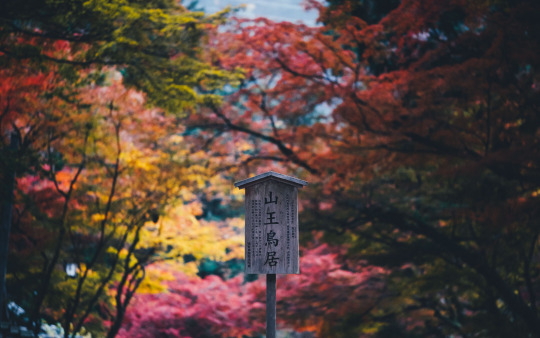






Shiga, Japan Kyu-Chikurin-In | Hiyoshi Taisha
7K notes
·
View notes
Text
Speaking of Nobu and gods. He really seems like he just doesn’t like the Buddhist sects, but he kind of has a “just in case” attitude with the Shinto gods for quite a while.
‘Cause like... he... kind of regretted Hieizan, you know? Sort of. Some time after he razed Enryakuji on Hieizan, he went and asked a Shinto priest like “I burned the mountain, do you think something bad would happen to the capital?” The priest said “So far there’s been no records of bad things happening just because something went wrong on Mount Hiei”, so Nobu was like “Oh okay then”.
He didn’t regret Enryakuji, no. It’s the mountain that he was worried about, because superstitions that the mountain is a barrier against demons/bad luck. Also, there’s a Hiyoshi Taisha in the mountain that got burned as collateral damage, so there’s that. “Hiyoshi Taisha” is the shrine of the mountain god. It’s so funny because it’s not really relevant to Hideyoshi.
Although, because it has a name like that, legends say that Toyotomi supporters use this shrine as a cover to worship the Toyokuni Daimyoujin (Hideyoshi) during the Anti Toyotomi crackdowns under the Edo bakufu. But well, in Nobu’s time it’s really not connected to Hideyoshi TBH.
Not entirely sure when he eventually just stopped caring about deities altogether. Frois’s writings can be a bit ????? sometimes, so I’m being careful with it. I always worry that he had misunderstood something due to culture miscommunication or him taking hyperbole too seriously.
5 notes
·
View notes
Photo
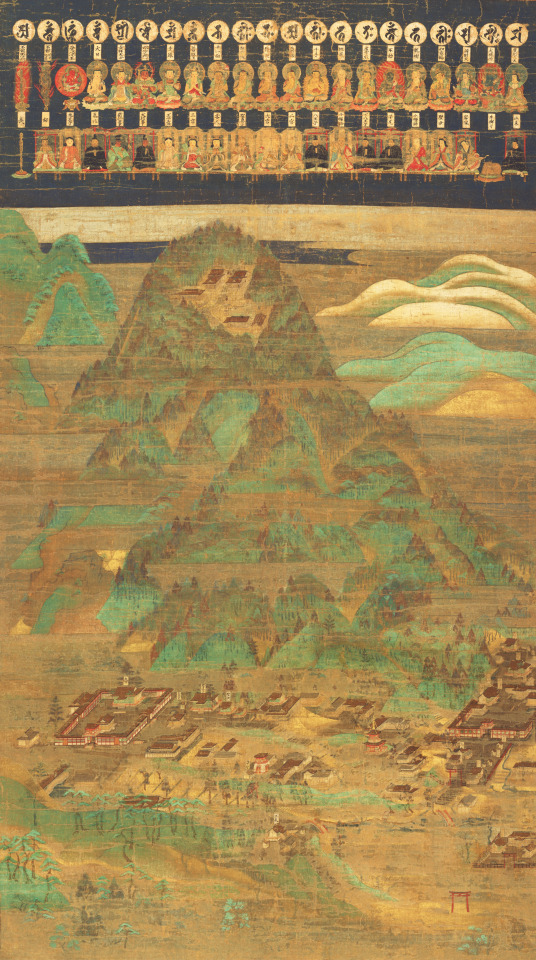
A hanging scroll of the Hie Sanno Miya Mandara (日吉山王宮曼荼羅), a mandala depicting the local deities of Hie Jinja Shrine (日吉神社), i.e. present-day Hiyoshi Taisha Grand Shrine (日吉大社) in Ōtsu, Shiga Prefecture, as manifestations of the Buddhist divinities of Mount Hiei (比叡山) north of Kyoto, with the deities and divinities matched up above and the two institutions situated geographically below
Ink and color on silk dating to the late 14th century, from the collection of the Nara National Museum
#japanese religion#japanese art#buddhist art#曼荼羅#mandala#滋賀県#shiga prefecture#大津市#otsu#近江国#omi province#比叡山#hieizan#mount hiei#日吉神社#hie jinja#山王権現#sanno gongen#日枝大社#hie taisha#日吉大社#hiyoshi taisha#日吉山王宮曼荼羅#hie sanno miya mandara
30 notes
·
View notes
Text
Anatomy of a Shintō Shrine
Hello! Shinto shrines have a generally recognizable structure that may be confusing to some, so I will explain a typical shrine layout.
鳥居 Torii: Torii are the gates at the entrance of a shrine, sometimes followed by a path leading up to the shrine itself. It marks that the land behind it is holy. Torii can also be within shrine grounds. They can be of varying sizes and material, and usually are the materials’ natural color or crimson.

手水舎 Chouzuya: A Chouzuya is where you purify your hands and mouth. You use these hishaku scoops to scoop water from the basin.
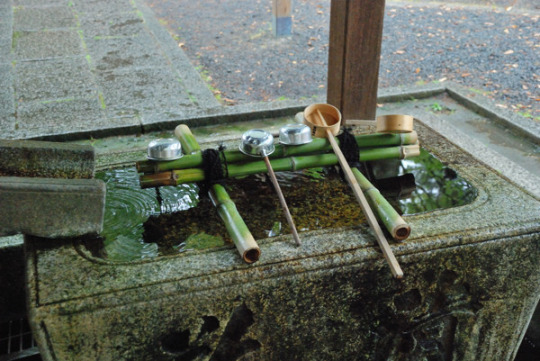
Pictured: Shimogoryo Jinja’s Chouzuya
There is a generally accepted specific procedure for using a Chozuya. Though purification is important in Shinto, this specific procedure and Chozuya in general are only for a shrine context. This sign is commonly seen at shrines:

Right to left, top to bottom it says to wash your left hand first, then your right, cup some water in your left hand and rinse out your mouth. Of course, you must not spit into the basin since people after you will use it too. I’ve often seen variations of this poster where worshippers are asked to lean the hishaku back so that the water cleans the handle, like so:
本殿 Honden: The honden is the main shrine building, where the kamisama is enshrined. It’s usually the largest on the shrine grounds. You cannot step foot within the building. Instead, you pray at the front. Some shrines have signs asking visitors not to take photos of the inside. Please respect those signs.

Pictured is Hiyoshi Taisha’s Higashi Hongu Honden.
お賽銭箱 Osaisen-bako: This is the box for monetary offerings. I grew up being told it was rude not to offer any money. Generally speaking, though, shrines are very dependent on money offerings for upkeep, maintenance etc. and more money is considered better. This is especially true for regional/rural shrines.

摂社 Sessha, and 末社 Massha: Smaller shrines to a different kamisama, which are affiliated with the shrine whose grounds they are on. They are usually there because the kamisama is in some way related to the gosaijin (enshrined kami) of the honden, such as being the child of the gosaijin. One shrine may have multiple sessha/massha. The distinction between sessha and massha is quite confusing and can vary by shrine as it was different pre-WWII.

Pictured: Umaji Isobe Jinja’s Sessha/Massha
授与所 Juyojo: Building where talismans/charms and fortunes are offered. Though shrines can be visited at any times, juyojo have hours of operation as they are staffed. You do not buy charms or ofuda, you offer money in exchange for the item or service.
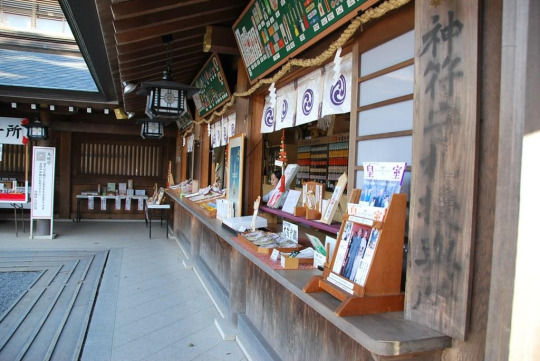
Pictured: Samukawa Jinja’s juyojo
*This is a general post, so there are exceptions for the naming conventions.
91 notes
·
View notes
Text
Hachi Shrine 八神社
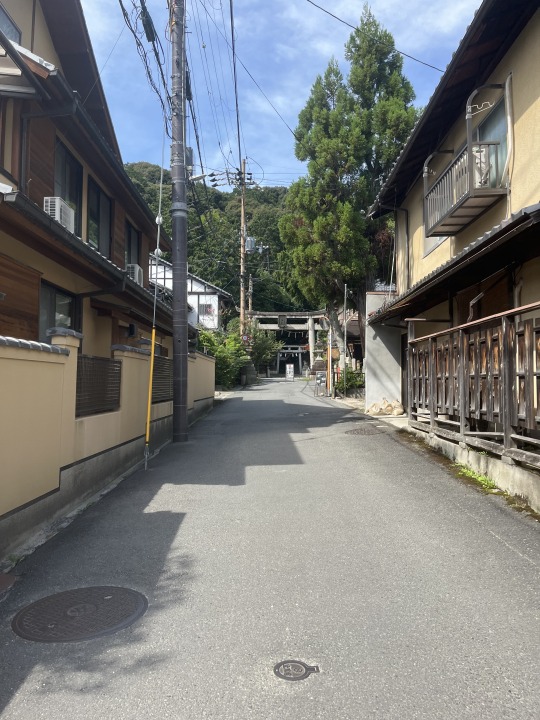
Located near the Philosopher's Path in Kyoto it enshrines 8 kami associated with the beginnings of Kojiki and the Nihonshoki texts.
Takamimusubi no Kami 高御産日神
Kamimusubi no Kami 神産日神
Ikumusubi no Kami 生産日神
Tarumusubi no Kami 足産日神
Tamatsumemusubi no Kami 玉積産日神
Ōmiyame 大宮売
Miketsu no Kami 御食津神
Kotoshironushi no Kami 事代主神
The Divine Virtues Associated with the Shrine Are:
Fulfillment of Wishes
Warding off Evil
Warding off misfortunes caused by the house's feng shui, direction, and weather.
Warding off Disaster

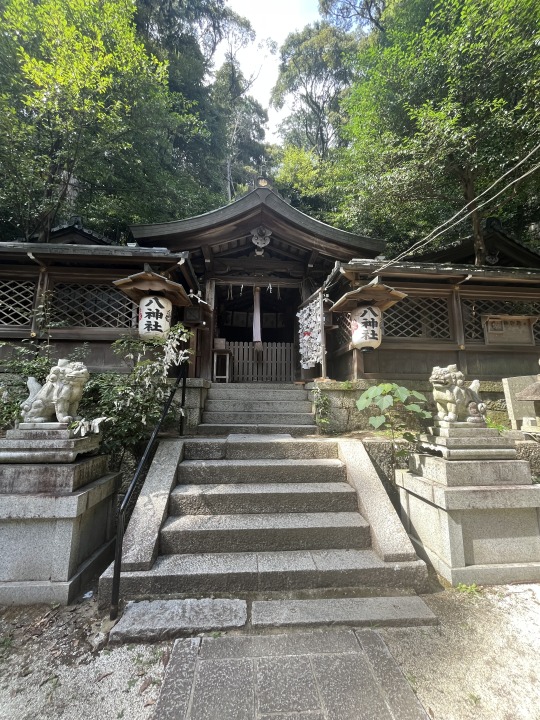
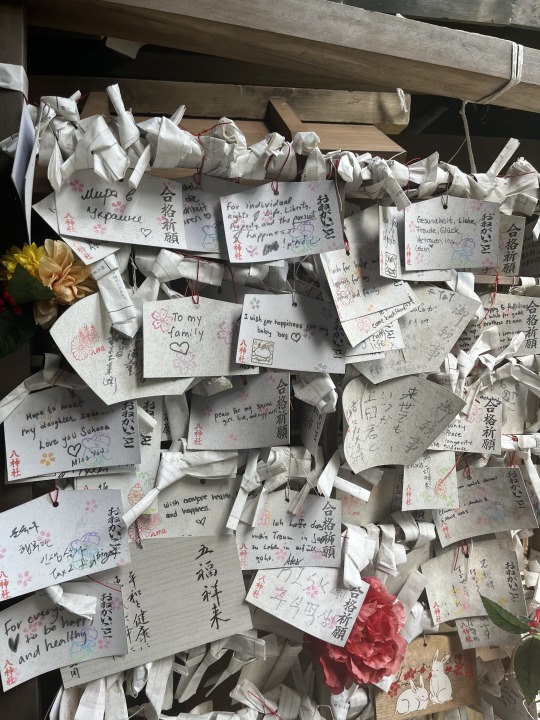
They also had side shrines for Inari Ōkami and Takaokami no Kami.
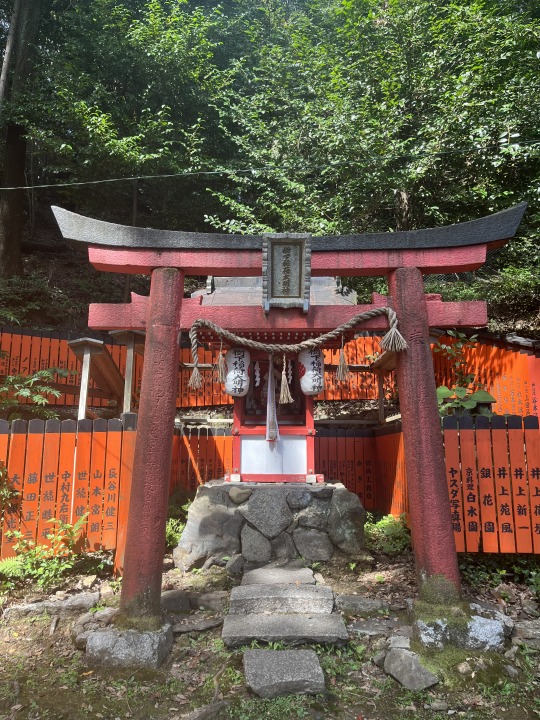
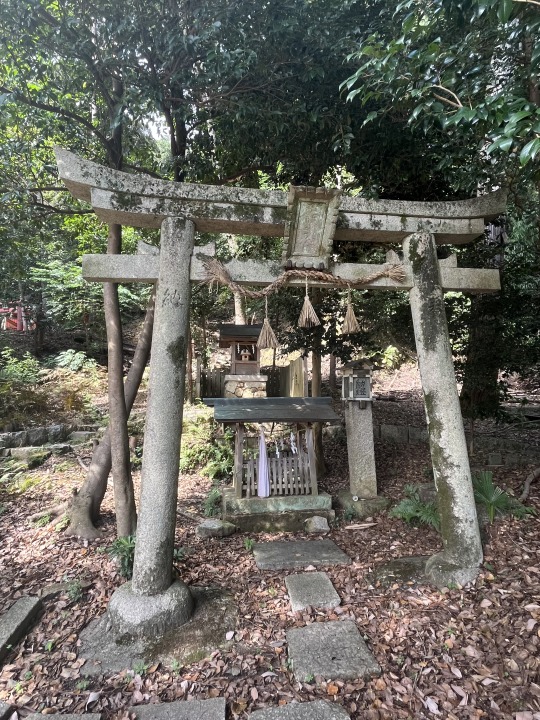
From the sign explaining the shrine (translated using DeepL):
"The head shrine is said to have been established in the Daido period (800-8007 AD) at the beginning of the Heian period (794-1185), and celebrated its 1,200th anniversary in the year 2007. However, in 1858, the entire village of Jodoji was destroyed by fire, including old documents, and the exact history of the shrine is not known.
However, in the "Shosha Nemoto Ki," it is written that on December 26, Engi 5 (905), a ceremony was held under the hall at Kaimine, Atago County, Yamashiro Province.
The later text states, "On the 26th day of the 12th month of the 5th year of Engi (105), the shrine will enshrine and enshrine 2,132 deities at the Kagionsaijo place in Kaimine, Atago County, Yamashiro Province.
In the text that follows, the eight temples of repose are located at the Aka-Kamiginomiya Shrine. It is located to the west of the present Nijo Shrine. It was moved to Yoshida Kaguraoka in the 16th year of Emperor Tsuchimikado's reign (1484). The following is the history of the shrine.
It is thought that the gods that had been enshrined by the Shinto priests in Engi 5 were enshrined at the site of a shrine that had long been enshrined as a local deity in the Jodo-ji area. The Tugashitaisha shrine in Soden also seems to have been enshrined sometime between the late Heian period (794-1185) and the Kamakura period (1192-1333), when the Hiei and Hiyoshi-taisha shrines were greatly expanding their power. At least by the time Ashikaga Yoshimasa built the Higashiyama-den in the Muromachi period (1333-1573), the eight shrines were enshrined as two main halls, eight deities in the east and Mashitaisha in the west, according to an illustration in the collection of Jishoji Temple.
Even after the eight temples were moved to Yoshida Kaguraoka (present-day Yoshida Shrine Omotomiya) in the 16th year of Bunmei Era (1618), it is believed that the eight deities of the eight temples continued to be enshrined there as they had been since the Heian Era (794-1185).
Today, the shrine is widely revered as the guardian of the Jodoji temple area and Jishoji temple."
1 note
·
View note
Photo

at Hiyoshi Taisha, Otsu ©shinji aratani
638 notes
·
View notes
